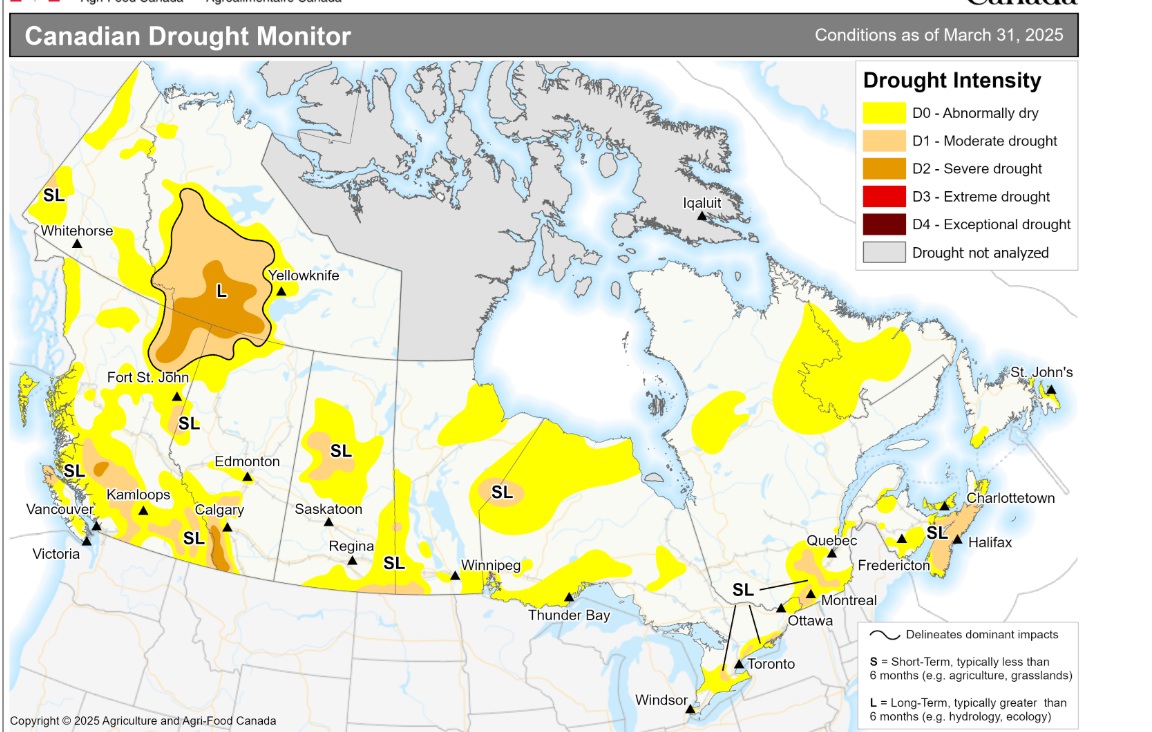Prairie dryness and drought is trending in the wrong direction ahead of the spring planting season.
The latest monthly update of the Canadian drought monitor on Wednesday showed 32% of Prairie agricultural lands were being impacted by abnormal dryness or some form of drought as of the end of March. That is up from 23% at the end of February and 26% in January.
March precipitation across the Prairie region varied with central Alberta seeing well above-normal precipitation because of numerous storm systems passing through, the monitor said. The rest of the region received below-normal precipitation. Southern Manitoba and eastern Saskatchewan were particularly dry, “continuing a dry winter trend, especially in southwestern Manitoba.”
Alberta
Despite good March precipitation through parts of Alberta, drought conditions deteriorated across the eastern slopes and southern foothills. Severe drought conditions expanded east of Banff and across the southern Rockies due to significant long-term deficits and concern over low snowpack, reduced streamflow and low runoff potential in the region. Low water levels also remained a concern for reservoirs in southern Alberta.
East-central Alberta saw improvements in abnormally dry to moderate drought conditions as 25 to 45 mm more than normal precipitation fell last month. Changes to drought across northern Alberta were minimal in March, with only a slight expansion of abnormally dry conditions in parts of the Peace region.
Saskatchewan
Drought conditions in Saskatchewan worsened in March as the province experienced dry and, in many areas, warmer conditions. Abnormally dry conditions expanded, and moderate drought remained along the Saskatchewan-US border primarily due to long-term moisture deficits. Over the past year, the southeastern corner of the province received 80 to 140 mm less precipitation than normal. While dry conditions have persisted for the past nine months, recent precipitation from a late-month storm did little to alleviate precipitation deficits in this area.
Abnormally dry conditions also expanded across northern Saskatchewan with the addition of a pocket of moderate drought due to significant short-term and ongoing long-term moisture deficits.
Manitoba
Limited precipitation fell across much of Manitoba in March, resulting in the expansion of drought conditions in the south. This was particularly the case in the southwest where abnormally dry conditions expanded, and a pocket of moderate drought emerged. Prolonged dryness during the fall and winter periods resulted in moderate drought conditions expanding from Melita to Killarney as well as an abnormally dry pocket to emerge west of Winnipeg. In contrast, west-central Manitoba saw slight improvements, as abnormally dry and moderate drought conditions were slightly reduced.
